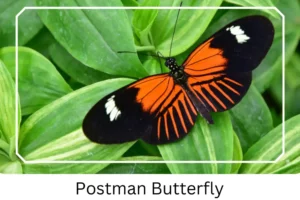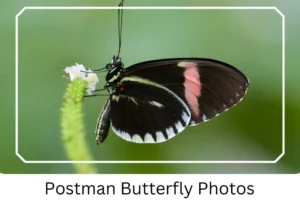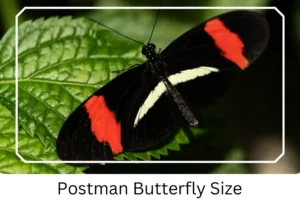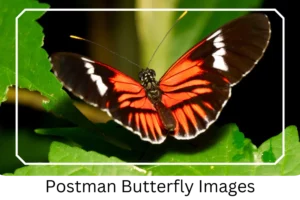Postman (Heliconius melpomene)
The Postman Butterfly, a member of the Heliconius genus, is celebrated for its striking colors and fascinating behaviors. Known scientifically as Heliconius melpomene, it embodies a rich tapestry of nature’s artistry combined with evolutionary marvels. This butterfly is not just a beautiful creature to observe but also a subject of extensive scientific study, particularly for its mimicry and adaptive strategies.
Scientific Classification
- Family: Nymphalidae
- Genus: Heliconius
- Common names: Common postman
- Scientific Name: Heliconius melpomene
Overview
Found predominantly in Mexico, Central, and South America, the Postman Butterfly thrives in diverse habitats, showcasing a variety of subspecies. Each subspecies has adapted to its environment through Müllerian mimicry, a survival tactic that involves mimicking the appearance of other Heliconius butterflies to deter predators. This adaptation, along with their unique life cycle stages and dietary preferences, makes the Postman Butterfly a fascinating subject for entomologists and butterfly enthusiasts alike.
Description and Identification
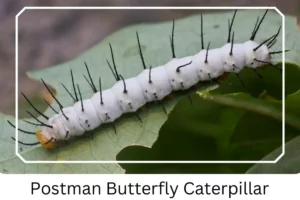 Caterpillar
Caterpillar
The Postman Butterfly’s journey begins as a caterpillar, measuring approximately 0.5 inches in length. These larvae are identifiable by their white bodies adorned with black spots and pronounced spines. Sporting an orange head with two black horns and a distinctive yellow anal plate, they are often found alone or in small groups, hinting at their solitary nature.
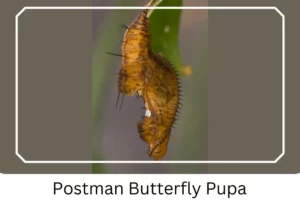 Pupa
Pupa
Transitioning into the pupa stage, the chrysalis exhibits a light brown hue with golden spots and about ten black spines along the ventral side. Its curved thorax and short black spined antennae contribute to its camouflage, mimicking the appearance of a dead leaf to evade predators.
Adult Butterfly
Sexual Dimorphism: While sexual dimorphism is not pronounced in Postman Butterflies, subtle differences in size and wing coloration can be observed between males and females, aiding in their identification.
Color and Appearance: Adults are primarily black, with variations of red, orange, yellow, or white bands on their forewings and occasionally on their hindwings. The diversity in coloration among subspecies is a testament to their adaptive evolution.
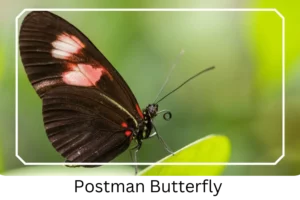 Average Wingspan: The wingspan ranges from 2.5 to 3.3 inches, supporting a slow, yet erratic flight pattern that is characteristic of the species.
Average Wingspan: The wingspan ranges from 2.5 to 3.3 inches, supporting a slow, yet erratic flight pattern that is characteristic of the species.
Flight Pattern: Their flight is an intricate dance through the air, a combination of slow movements interspersed with sudden, unpredictable changes in direction.
Eggs
Laid singly, the yellow eggs are a promise of the next generation, continuing the cycle of life for these remarkable butterflies.
Quick Facts | |
| Distribution | Common in Mexico, found throughout Central and South America. |
| Habitat | Prefers sunny open lands, forest edges, pine, and pine-oak forests, often near water. |
| Lifespan of Adults | Approximately 6 to 9 months. |
| Host Plants | Passionflower species, including Passiflora oerstedii and Passiflora menispermifolia. |
| Adult Diet | Consists of pollen, flower nectar, and ripe/rotting fruits. |
How to Identify Postman Butterfly?
Identifying Postman Butterflies involves looking for their signature color patterns and behaviors. The adults are mostly black with distinct red, orange, yellow, or white bands that make them stand out. Unlike other butterflies, Postman Butterflies have a unique flight pattern that is slow and erratic, making them easier to observe. Their habitats are also a clue; they prefer sunny open lands and forest edges, especially near water sources. When observing caterpillars, look for the distinctive white body with black spots and the orange head with black horns. Remember, the variation in wing coloration and pattern can help differentiate between the numerous subspecies and their mimic counterparts.
Did You Know?
- The toxins ingested from passionflower vines during the larval stage remain in the Postman Butterfly’s body into adulthood, serving as an effective defense mechanism against predators.
- Due to their distasteful flavor, resulting from the stored toxins, they have few natural predators.
- Among the Heliconius genus, Postman Butterflies are some of the longest-lived, with adults living up to 9 months.
- The appearance of the pupa, resembling a dry leaf, is a clever disguise against predators, showcasing nature’s ingenuity in survival strategies.
- Postman Butterflies have been observed to return to the same resting spots each night, demonstrating a remarkable sense of navigation and memory.
Conclusion
The Postman Butterfly is more than just a visual spectacle; it is a story of survival, adaptation, and the intricate relationships within ecosystems. Through their vivid colors, unique life cycle, and the fascinating mimicry tactics they employ, these butterflies offer invaluable insights into the natural world. Observing and studying them not only enriches our understanding of biodiversity but also highlights the importance of conserving their habitats for future generations to admire and learn from.
Postman Butterfly Pictures

Scientific Classification

- Family: Nymphalidae
- Genus: Heliconius
- Common names: Common postman
- Scientific Name: Heliconius melpomene

